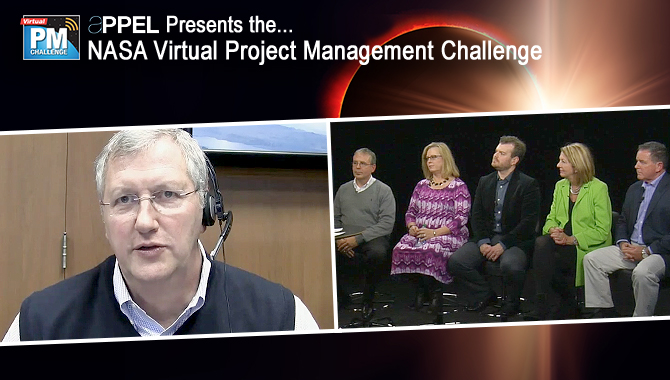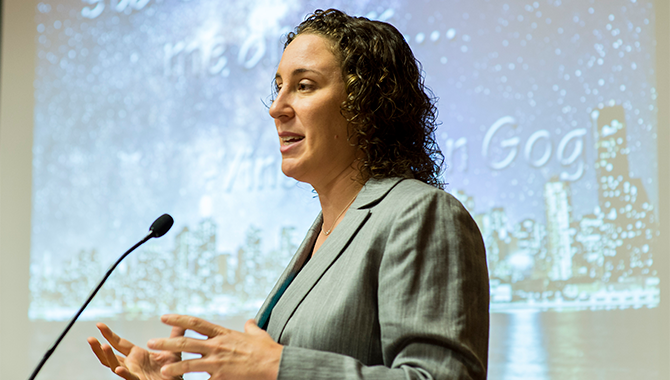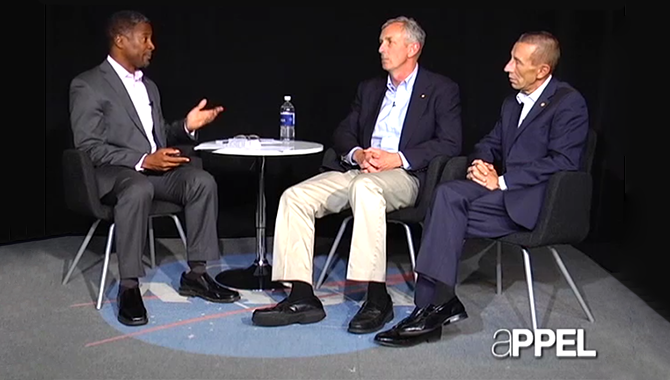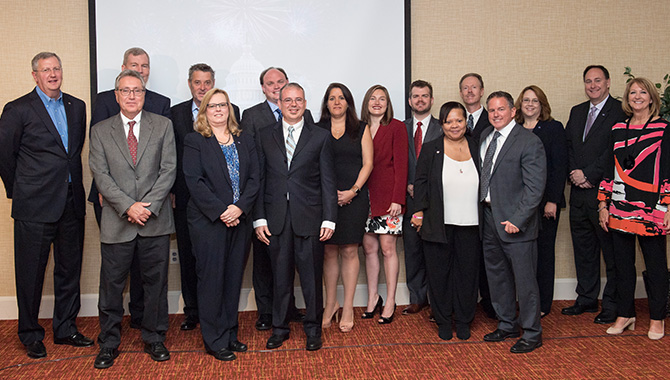
From left: NASA Chief Engineer Ralph Roe, SELDP graduates David Rutishauser, Lisa Smith, and Sean Laughter, plus SELDP Leadership Facilitator and Coach Cindy Zook and Program Manager Kevin Magee discussed the value of the program to the agency and to NASA engineers.
Credit: NASA
How can engineers hone their leadership and technical skills to enhance mission success? A recent NASA Virtual Project Management (PM) Challenge offered answers.
For many NASA engineers, their desired professional trajectory leads toward becoming a systems engineer and project leader. While course work—either in school or through a NASA program such as APPEL—can help them achieve this goal, most engineers need additional guidance and opportunities to fully realize their potential. During the Virtual PM Challenge Aspire Higher: How NASA is Developing the Next Generation of Engineering Leaders, NASA Chief Engineer Ralph Roe emphasized the importance of accessing technical development opportunities.
“[Y]ou need good hands-on experience to complement the course work you’ve taken either in college or after college,” said Roe. “You’re going to learn everything you need from a process standpoint in school and other courses that we teach, but that hands-on experience is what’s going to make the difference between being a good systems engineer and a great systems engineer.”
To provide that crucial hands-on experience in conjunction with leadership training, NASA offers the Systems Engineering Leadership Development Program (SELDP). A comprehensive program for mid-career NASA engineers, SELDP provides 18 months of intensive leadership development, hands-on technical assignments, mentoring, coaching, and industry and NASA center benchmarks.
SELDP management and three 2017 graduates of the program spent the Virtual PM Challenge discussing what makes SELDP so valuable to NASA engineers and how it benefits the agency. In particular, they noted that while some NASA centers offer development programs, SELDP is distinct because it is agency wide.
“Our program is different than center development programs in several ways,” said SELDP program manager Kevin Magee. “The first is that our cohorts are made up of participants across NASA centers and this allows participants to build collegial relationships across the agency that will stay with them for the rest of their careers. Secondly, they have to accept a nine-month assignment away from their home center. This is intended to introduce new and enhance existing engineering competencies and also expose them to technical experiences that they may not get from their home center. And then lastly, they get exposed to a broad base of world-class capabilities across NASA as we visit the NASA centers, and they also get to go to industry as we benchmark organizations.”

From left: SELDP graduates David Rutishauser, Lisa Smith, and Sean Laughter, plus SELDP Leadership Facilitator and Coach Cindy Zook, Program Manager Kevin Magee, and Moderator Ramien Pierre discussed the value of the program to the agency and to NASA engineers.
Credit: NASA
Participants in SELDP spend nine months on a detail at an “away” center in order to rapidly advance their abilities. They don’t get to choose their new center or project. Instead, they are matched by the program to nine-month details designed to challenge them from both a technical and leadership perspective.
“What we’re trying to do is look across the NASA life cycle and different phases, and see where [participants’] skill sets lie, and then put them in a position that’s going to stretch them,” said Magee. “So if they were working the front of the life cycle, we’re going to probably give them a project that’s going to have competencies in the back end of the life cycle.”
“Being able to stretch happens best when you’re out of your comfort zone,” said Cindy Zook, SELDP Leadership Facilitator and Coach. “These people pick up their lives, move across the country, drop into a place where they’re not the resident expert [and] they don’t have their natural support systems around them. They’re very out of comfort zone, and we see that accelerates the learning process.”
Before SELDP, program graduate Sean Laughter, Standards Verification and Integration Lead for Commercial Crew at Langley Research Center (LaRC), had spent his entire career in subscale aeronautic applications. SELDP sent him to Johnson Space Center (JSC) to work on a human spaceflight project. “From an engineering technical standpoint, the detail was extremely important because, particularly for me going to a completely different area, you get all that new exposure to the life cycle,” he said.
“I wasn’t happy when I first got my detail,” said David Rutishauser, Avionics Lead for the Safe and Precise Landing Integrated Capabilities Evolution (SPLICE) Project at JSC. “It was mainly because I had the wrong idea about how these selections were made. I was assuming that I had spent five years at Langley so I had aeronautical experience in the agency, and that I had years at Johnson Space Center doing manned spaceflight, so I thought the logical gap in my experience would be robotic exploration. I figured I was going to [the Jet Propulsion Laboratory] JPL or Goddard [Space Flight Center (GSFC)].”
Instead, Rutishauser was placed at Kennedy Space Center (KSC), which, like JSC, focuses on human spaceflight. He eventually learned that SELDP program management had a different vision than he expected for accelerating his career growth. “[T]hey were looking at how I was going to be a leader and what sort of leadership role I would have to serve in in that assignment. That was the gap [they were trying to fill] more so than the technical content,” he said.
Lisa Smith, Lead Systems Engineer in the Environmental Life Support System (ECLSS) at Marshall Space Flight Center (MSFC), found one of the most impactful aspects of her detail at GSFC was learning the culture of a new center. “At NASA, we talk about diversity of thought, so [the detail] allows you to see how other centers approach system engineering from a different perspective and see how they tailor and how they balance the whole engineering process at different cycles, on a different program, in different areas. It was very valuable.”
She also appreciated the connections she formed at GSFC. “You develop those relationships, so when we partner with other centers going forward on things, it’ll just make things a whole lot easier for us.”
In addition to the nine-month detail, participants receive ongoing leadership coaching through multiple workshops led by Zook.
“That’s what I think is very unique about this program. It assumes a certain level of technical competence in systems engineering already, so the workshops are really looking at the leadership part. They’re looking to stretch you, like through the detail,” said Laughter.
The program is built around a set of core models, such as “Leadership is a Choice,” which helps participants identify their core values and align those with agency values. In addition, said Zook, “We do a lot of work with dialogue. When you think about the job of a systems engineer, they’re bridge builders. Their job is to be connectors of all of the system components across disciplines and things. And so the ability to be powerful collaborators is critical, and having hard conversations and crucial conversations is essential.”
The program also incorporates the use of self-assessment tools, such as Myers-Briggs Type Indicator, and emphasizes the importance of providing and receiving peer feedback. “We do heavy doses of peer feedback in every workshop. These folks walk out of six or seven [workshops] knowing how to give peer feedback and coaching at a very high level,” said Zook. Most important, she added, the program establishes a learning community for the group that enables them to support and learn from each other through the course of the program and beyond.
As part of its leadership training, SELDP participants benchmark with non-government and non-aerospace organizations such as the Cleveland Clinic. “We go to other organizations that are outside the aerospace industry [because] they provide some leadership insights,” said Zook. The benchmarks challenge participants to make connections between what they learn and how they could apply those learnings to their work at NASA. “I think being able to make those kinds of connections, from a leadership standpoint, is very profound,” she added.
According to those who’ve gone through the program, the experience is invaluable, both professionally and personally.
“[SELDP] far exceeded my expectations. It’s very multi-layered, and it helps you to dig deep and to examine yourself and your core values, and how you align with NASA. But it also helps you build relationships, and challenges you professionally and personally,” Smith said. “It also gave me the broader perspective of NASA…that I was looking for.”
“For me, [the benefit] was more than just the tools and the environment. It was really the transformation. Cindy warned us at the beginning of the program that, ‘You’re all going to undergo a transformation.’ And I was skeptical. I said, ‘Okay, we’ll see.’ [But] I really did,” said Rutishauser.
With its comprehensive approach and unique opportunities, the program is valuable both to NASA engineers and the agency overall. With SELDP, said Roe, “[Y]oung systems engineers [get] an opportunity to gain that hands-on experience at other centers so that they develop the skills and leadership qualities that we’re looking for.”
NASA engineers interested in applying to the next SELDP class will be able to do so in early 2018. The next Call for Nominations will go out to agency centers on February 1, 2018, with applications due back by April 16, 2018. To learn more about the program, visit the SELDP section of the APPEL website. Prospective candidates can view eligibility criteria here.
Throughout the Virtual PM Challenge, the graduates discussed their experiences in SELDP and the impact it had on their development. They also offered advice to those interested in applying to the program, and suggestions to engineers outside NASA about how they might create similar development opportunities for themselves. View the complete Virtual PM Challenge, Aspire Higher: How NASA is Developing the Next Generation of Engineering Leaders, now available online.
To receive email notification about upcoming NASA Virtual PM Challenge sessions and recorded session availability, please subscribe to the Virtual PM Challenge email list.









